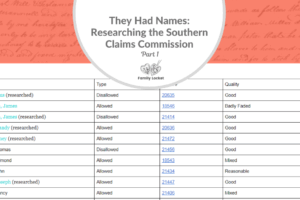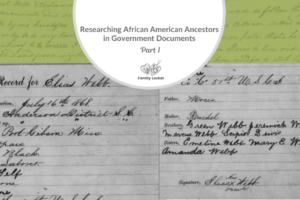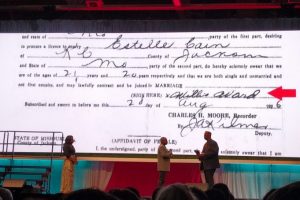
Tracing the enslaved in U. S. records is challenging and time-consuming. Because enslaved people typically only had first names until emancipation, we hope to find identifying information, such as age and possible family groups, in records like the 1850 and 1860 slave schedules. We also look for records post-emancipation, such as the 1867 Voter Registration and the 1870 census. Tracing people forward in time presents its own challenges because the formerly enslaved may have chosen to use a different surname between census years. Perhaps they took their enslaver’s surname at first, then decided to change names. In that case, family groups and ages again become essential.
Two projects were recently highlighted by FamilySearch that can aid in this research: the Enslaved.org project and the 1900 U.S. Census dataset available at FamilySearch.org. This was a collaboration between Michigan State University (MSU) and FamilySearch International. The news release states:
Michigan State University (MSU) and FamilySearch International are happy to announce an extensive expansion to MSU’s online collection Enslaved: Peoples of the Historical Slave Trade (Enslaved.org), a project that documents the lives of formerly enslaved individuals of African descent. The newly expanded collection uses 1900 United States census data to significantly enhance the ability to discover formerly enslaved individuals and their families for genealogical and academic research. This exciting new, free resource can be accessed now at Enslaved.org and FamilySearch.org.
MSU and FamilySearch determined that the 1900 census could have the greatest impact on MSU’s Enslaved.org initiative because of its potential to identify about 2 million people named in the census who were likely enslaved before emancipation in the United States. (Enslaved individuals were not named in many historical records, including U.S. censuses. Censuses taken after 1863 are sometimes the first records to include these individuals by name.) FamilySearch then worked with Brigham Young University’s Record Linking Lab to identify the individuals in the census, along with links to the original census images on FamilySearch.org and records in the FamilySearch Family Tree.
My ancestor, Thomas B. Royston, enslaved up to sixteen people on his plantation in Chambers County, Alabama. Despite searching court records and deeds, I’ve found no names for any of these individuals. I do have their gender and ages from the 1850 and 1860 slave schedules.1 I also have a black Royston family who appears on the 1870 census in Chambers County.2

1870 Census, Drew Royston Household, Chambers County, Alabama
The Royston surname is a clue to a connection, but doesn’t prove it. However, another piece of evidence adds strength to the argument that Drew Royston may have been enslaved by Thomas B. Royston. Drew Royston lived next to the Joseph Slagle household in 1870. Joseph had married Thomas B. Royston’s oldest daughter, Mary Elizabeth, on 30 January 1855 in Chambers County.3 The 1860 slave schedule indicates that Joseph owned 1 male, aged 16, so this would not be Drew Royston.4 Instead, Drew and his household were probably enslaved on the Thomas B. Royston plantation.
In 1860, the census slave schedule shows the following enslaved individuals enslaved by Thomas.5

1860 Slave Schedule, Thomas B. Royston, Chambers County, Alabama
Correlating the sex and age, it appears Drew Royston fits most closely with the male born in 1815. His inferred wife, Ann, could be one of the females born in 1822. Susan could be the female born in 1852, Henry the male born in 1855, and Georgiana one of the females born in 1857. It is possible that the family lived intact on the Royston plantation. Another possibility to consider, though, is that Drew and Harriet were on different plantations and were only able to live together post-emancipation.
1900 U.S. Census Dataset on FamilySearch.org
No black Royston family appears in Chambers County in 1880; however, using the filtered dataset on FamilySearch, I found the family of John Royston in 1900. They lived in Lafayette, Chambers County seat. Was John another of the enslaved people on the Royston plantation? Born in 1850, there is no perfect match on the 1860 slave schedule, but ages for the enslaved were often not known, and this could be an estimate.

Search results for “Royston” on the 1900 U.S. Census Dataset
The John and Harriet Royston household contains four children, but they are not included in the specialized 1900 dataset. It includes only those who were born before emancipation. This can help to quickly identify possible candidates for the enslaved.

1900 Census for John Royston, Chambers County, Alabama
The profile for John and Harriet Royston had been created on FamilySearch but needed some merging with duplicate profiles. After reviewing the records, I updated the family’s profile. Hopefully, anyone descended from this family will eventually be able to trace their lineage back to them.
Enslaved.org
I also wanted to search the database at Enslaved.org for “Royston” and found three entries. None of them corresponded to any of the Royston family I’ve researched, but this database will expand as more records are added to it. Clicking on each record brought up a source such as a deed, probate, or petition.

Search for “royston” at Enslaved.org
You can search by gender, age, ethnodescriptor, role type, occupation, status, and more. It is encouraging to see projects where we can search for the enslaved people in our family history. I added these African American Royston individuals to my research log and hope additional evidence will come to light eventually.
Best of luck in all your genealogy research!
Sources
- 1850 U.S. Census, Chambers County, Alabama, slave schedule, District 19, page 457 (penned), Thomas B. Royston owner; digital image, Ancestry (http://ancestry.com: accessed 24 April 2024); citing NARA microfilm publication M432.1860 U.S. Census, Chambers County, Alabama, slave schedule, Northern Division, page 48 (penned), Thomas B. Royston owner; digital image, Ancestry (http://ancestry.com: accessed 13 November 2016); citing NARA microfilm publication M653 roll 4.
- 1870 U.S. Census, Chambers County, Alabama, population schedule, Beat No 2, p. 20 (penned), p.29 (stamped), dwelling 156, family 156, Drew Royston household; digital image, Ancestry (http://www.ancestry.com : accessed 22 June 2025); citing NARA microfilm publication M593, roll 6.
- Chambers County, Alabama, “Marriage Records v. 5 1853-1866,” Slagle-Royston 1855, p. 218, Judge of Probate, FHL microfilm 1,290,837, item 2.
- 1860 U.S. Census, Chambers County, Alabama, slave schedule, Northern Division, page 48 (penned), Julius [Joseph]Slagle owner; digital image, Ancestry (http://ancestry.com: accessed 13 November 2016); citing NARA microfilm publication M653 roll 4.
- 1860 U.S. Census, Chambers County, Alabama, slave schedule, Northern Division, page 48 (penned), Thomas B. Royston owner; digital image, Ancestry (http://ancestry.com: accessed 13 November 2016); citing NARA microfilm publication M653 roll 4.













Leave a Reply
Thanks for the note!